What is “Your computer was locked” pop up scam? The “Your computer was locked” pop up scam is a misleading advertising that created in order to force you into calling a fake Microsoft Tech Support. If unwanted “Your computer was locked” pop-up alerts keeps popping up on your screen every time you use the web browser to surf the Web, then may be possible that an ‘ad-supported’ software (also known as adware) get installed on your computer.
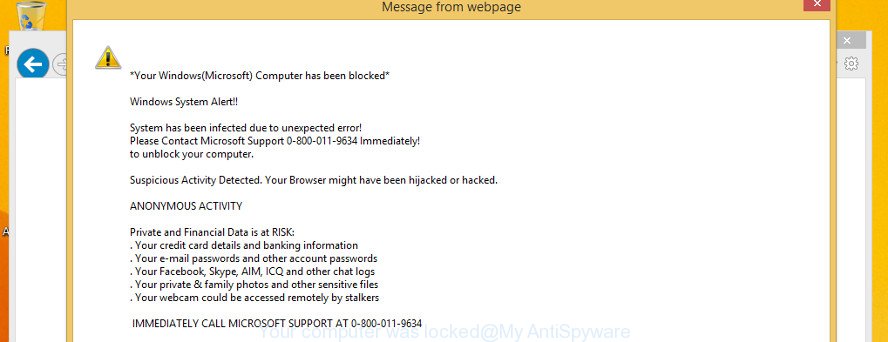
The ad supported software usually gets installed as a part of some free software. Do not be surprised, it happens, especially if you’re an active Net user. But this does not mean that you should reconcile with these unwanted “Your computer was locked” pop up alerts. Use the steps below to clean your computer ASAP, as the adware can be a way to affect your personal computer with more dangerous malicious programs like viruses and trojans. The few simple steps which follow, I’ll show you how to uninstall adware and thereby remove “Your computer was locked” scam from your computer forever.
The adware that displays misleading “Your computer was locked” alerts on your system is the part of the software that is used as an online promotional tool. It’s developed with the sole purpose to open dozens of advertisements, and thus to promote the goods and services in an open internet browser window. The adware can substitute the legitimate sponsored links on misleading or even banners that can offer to visit harmful web pages.
What is more, the adware can analyze your location and which Internet webpages you visit, and then present advertisements to the types of content, goods or services featured there. Ad-supported software creators can gather and sell your browsing information and behavior to third parties.
The ad-supported software usually hijacks only the Microsoft Edge, Google Chrome, Mozilla Firefox and Microsoft Internet Explorer by modifying the web browser’s settings or installing a harmful extensions. Moreover, possible situations, when any other internet browsers will be affected too. The adware will perform a scan of the machine for internet browser shortcut files and alter them without your permission. When it infects the browser shortcuts, it’ll add the argument like ‘http://site.address’ into Target property. So, each time you start the web browser, you’ll see the “Your computer was locked” scam.
So, obviously, you need to get rid of the adware ASAP. Use the free steps below. This guide will help you clean your PC of adware and thereby get rid of the “Your computer was locked” popup alerts.
Remove “Your computer was locked” pop-up scam (Virus removal guide)
Without a doubt, the ad-supported software is harmful to your personal computer. So you need to quickly and completely delete this adware that causes internet browsers to show misleading “Your computer was locked” pop-up warnings. To remove this adware, you can use the manual removal guide which are given below or free malware removal tool like Zemana Anti Malware, MalwareBytes Anti Malware (MBAM) or HitmanPro (all are free). We advise you use automatic removal solution that will allow you to get rid of “Your computer was locked” popup warnings easily and safely. Manual removal is best used only if you’re well versed in PC system or in the case where ad-supported software is not uninstalled automatically. Read it once, after doing so, please print this page as you may need to shut down your internet browser or restart your system.
To remove “Your computer was locked” pop-up scam, perform the following steps:
- How to manually get rid of “Your computer was locked” scam
- “Your computer was locked” pop-up automatic removal
- How to stop “Your computer was locked” popup scam
- How did you get infected with “Your computer was locked” scam
- To sum up
How to manually get rid of “Your computer was locked” scam
The following instructions is a step-by-step guide, which will help you manually delete “Your computer was locked” popup from the Chrome, Mozilla Firefox, Microsoft Internet Explorer and Edge.
Remove questionable software using Windows Control Panel
First method for manual ad supported software removal is to go into the Windows “Control Panel”, then “Uninstall a program” console. Take a look at the list of software on your machine and see if there are any dubious and unknown programs. If you see any, you need to remove them. Of course, before doing so, you can do an Net search to find details on the program. If it is a potentially unwanted program, adware or malicious software, you will likely find information that says so.
Make sure you have closed all web browsers and other programs. Next, uninstall any unwanted and suspicious apps from your Control panel.
Windows 10, 8.1, 8
Now, press the Windows button, type “Control panel” in search and press Enter. Choose “Programs and Features”, then “Uninstall a program”.
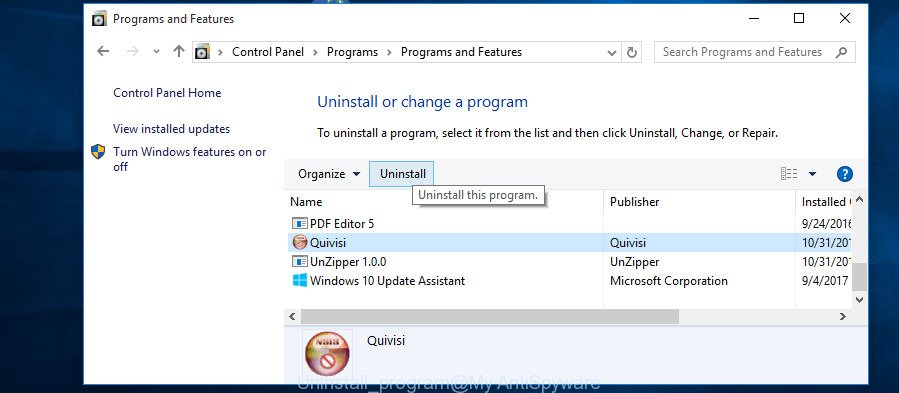
Look around the entire list of apps installed on your system. Most likely, one of them is the ad supported software that causes multiple misleading “Your computer was locked” alerts and pop-ups. Choose the dubious program or the application that name is not familiar to you and delete it.
Windows Vista, 7
From the “Start” menu in Windows, select “Control Panel”. Under the “Programs” icon, select “Uninstall a program”.

Select the dubious or any unknown apps, then press “Uninstall/Change” button to delete this unwanted program from your PC system.
Windows XP
Click the “Start” button, select “Control Panel” option. Click on “Add/Remove Programs”.
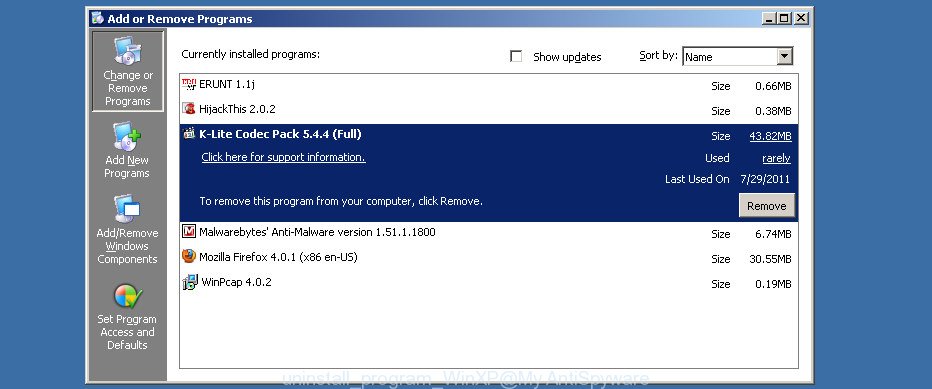
Select an undesired program, then click “Change/Remove” button. Follow the prompts.
Remove “Your computer was locked” fake alerts from Google Chrome
If your Google Chrome browser is rerouted to the “Your computer was locked” scam, it may be necessary to completely reset your browser program to its default settings.
First open the Chrome. Next, click the button in the form of three horizontal dots (![]() ).
).
It will display the Google Chrome menu. Choose More Tools, then press Extensions. Carefully browse through the list of installed addons. If the list has the extension signed with “Installed by enterprise policy” or “Installed by your administrator”, then complete the following guidance: Remove Chrome extensions installed by enterprise policy.
Open the Chrome menu once again. Further, press the option named “Settings”.

The web browser will show the settings screen. Another way to show the Google Chrome’s settings – type chrome://settings in the web-browser adress bar and press Enter
Scroll down to the bottom of the page and click the “Advanced” link. Now scroll down until the “Reset” section is visible, as shown on the image below and press the “Reset settings to their original defaults” button.

The Google Chrome will display the confirmation dialog box as shown on the image below.

You need to confirm your action, click the “Reset” button. The browser will start the procedure of cleaning. Once it’s finished, the web-browser’s settings including startpage, new tab and search engine back to the values which have been when the Chrome was first installed on your computer.
Remove “Your computer was locked” fake alerts from Internet Explorer
If you find that IE browser settings like home page, new tab and search provider by default had been modified by adware which displays misleading “Your computer was locked” popup warnings on your personal computer, then you may return your settings, via the reset web browser procedure.
First, start the Microsoft Internet Explorer, click ![]() ) button. Next, press “Internet Options” as shown in the following example.
) button. Next, press “Internet Options” as shown in the following example.

In the “Internet Options” screen select the Advanced tab. Next, click Reset button. The Internet Explorer will open the Reset Internet Explorer settings dialog box. Select the “Delete personal settings” check box and click Reset button.

You will now need to restart your personal computer for the changes to take effect. It will remove ad supported software that causes misleading “Your computer was locked” pop-up warnings on your browser, disable malicious and ad-supported web browser’s extensions and restore the Microsoft Internet Explorer’s settings like new tab page, start page and search provider by default to default state.
Get rid of “Your computer was locked” popup scam from Mozilla Firefox
If Firefox settings are hijacked by the adware, your web browser displays undesired pop-up ads, then ‘Reset Mozilla Firefox’ could solve these problems. However, your saved bookmarks and passwords will not be lost. This will not affect your history, passwords, bookmarks, and other saved data.
First, launch the Mozilla Firefox and click ![]() button. It will show the drop-down menu on the right-part of the internet browser. Further, click the Help button (
button. It will show the drop-down menu on the right-part of the internet browser. Further, click the Help button (![]() ) as displayed in the following example.
) as displayed in the following example.

In the Help menu, select the “Troubleshooting Information” option. Another way to open the “Troubleshooting Information” screen – type “about:support” in the web browser adress bar and press Enter. It will show the “Troubleshooting Information” page as displayed on the screen below. In the upper-right corner of this screen, click the “Refresh Firefox” button.

It will show the confirmation prompt. Further, click the “Refresh Firefox” button. The Mozilla Firefox will start a task to fix your problems that caused by the “Your computer was locked” scam. When, it is finished, click the “Finish” button.
Check the Task Scheduler Library
Once installed, the adware can add a task in to the Windows Task Scheduler Library. Due to this, every time when you start your PC, it will open the “Your computer was locked” scam. So, you need to check the Task Scheduler Library and delete all malicious tasks that have been created by adware.
Press Windows and R keys on your keyboard together. It will display a dialog box that called Run. In the text field, type “taskschd.msc” (without the quotes) and click OK. Task Scheduler window opens. In the left-hand side, click “Task Scheduler Library”, as on the image below.
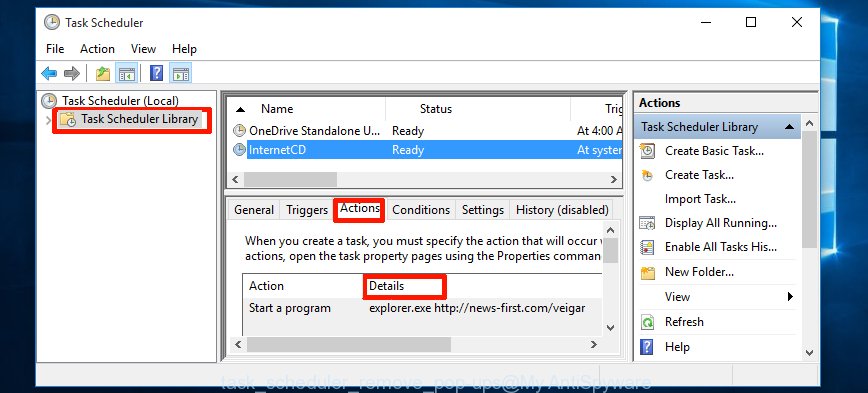
Task scheduler, list of tasks
In the middle part you will see a list of installed tasks. Select the first task, its properties will be open just below automatically. Next, press the Actions tab. Necessary to look at the text which is written under Details. Found something suspicious”, then you need delete this task. If you are not sure that executes the task, then google it. If it’s a component of the malicious program, then this task also should be removed.
Further press on it with the right mouse button and select Delete as shown on the screen below.

Task scheduler, delete a task
Repeat this step, if you have found a few tasks that have been created by unwanted applications. Once is finished, close the Task Scheduler window.
“Your computer was locked” pop-up automatic removal
If you are an unskilled computer user, then we recommend to run free removal utilities listed below to remove “Your computer was locked” popup scam for good. The automatic method is highly recommended. It has less steps and easier to implement than the manual way. Moreover, it lower risk of system damage. So, the automatic “Your computer was locked” removal is a better option.
How to remove “Your computer was locked” pop up scam with Zemana Anti-Malware
Zemana Free is extremely fast and ultra light weight malicious software removal tool. It will help you delete “Your computer was locked” popup, adware, potentially unwanted programs and other malware. This program gives real-time protection that never slow down your system. Zemana Free is designed for experienced and beginner computer users. The interface of this tool is very easy to use, simple and minimalist.
Visit the following page to download the latest version of Zemana for MS Windows. Save it on your MS Windows desktop or in any other place.
164813 downloads
Author: Zemana Ltd
Category: Security tools
Update: July 16, 2019
Once the downloading process is finished, start it and follow the prompts. Once installed, the Zemana AntiMalware (ZAM) will try to update itself and when this process is complete, click the “Scan” button to perform a system scan with this utility for the adware that causes web-browsers to display misleading “Your computer was locked” fake alerts.

Depending on your PC system, the scan can take anywhere from a few minutes to close to an hour. While the Zemana AntiMalware (ZAM) utility is scanning, you may see number of objects it has identified as being affected by malicious software. Review the report and then press “Next” button.

The Zemana Anti Malware will delete adware that shows misleading “Your computer was locked” pop-up scam on your computer.
Scan your computer and get rid of “Your computer was locked” pop up scam with HitmanPro
The Hitman Pro utility is free (30 day trial) and easy to use. It can check and remove malware, potentially unwanted apps and adware in Internet Explorer, Chrome, Mozilla Firefox and MS Edge web browsers and thereby remove the “Your computer was locked” scam. Hitman Pro is powerful enough to find and remove malicious registry entries and files that are hidden on the PC.
Visit the following page to download HitmanPro. Save it to your Desktop.
After the downloading process is finished, open the directory in which you saved it and double-click the Hitman Pro icon. It will start the Hitman Pro tool. If the User Account Control dialog box will ask you want to launch the application, press Yes button to continue.

Next, click “Next” . HitmanPro program will scan through the whole PC system for the adware which cause the “Your computer was locked” scam to appear. This process can take quite a while, so please be patient. When a malware, adware or potentially unwanted software are detected, the number of the security threats will change accordingly.
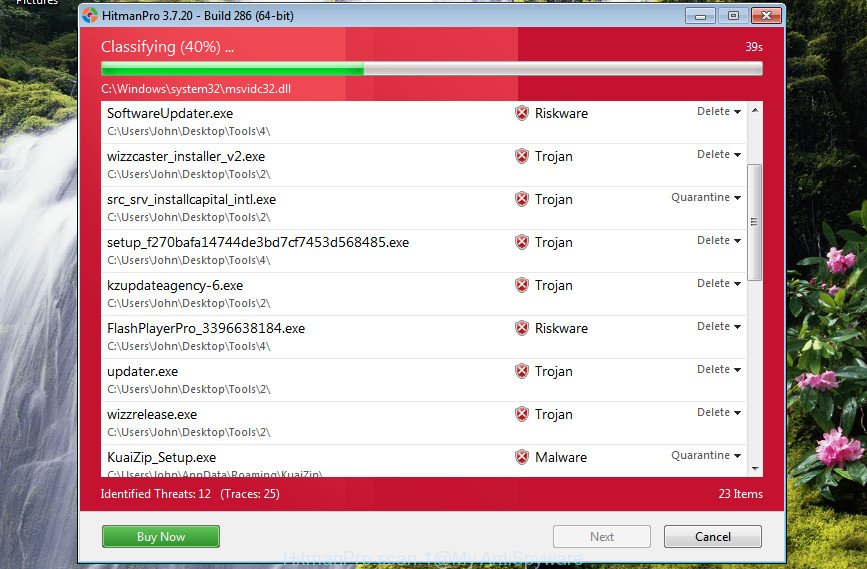
As the scanning ends, HitmanPro will open a screen that contains a list of malware that has been detected as shown below.
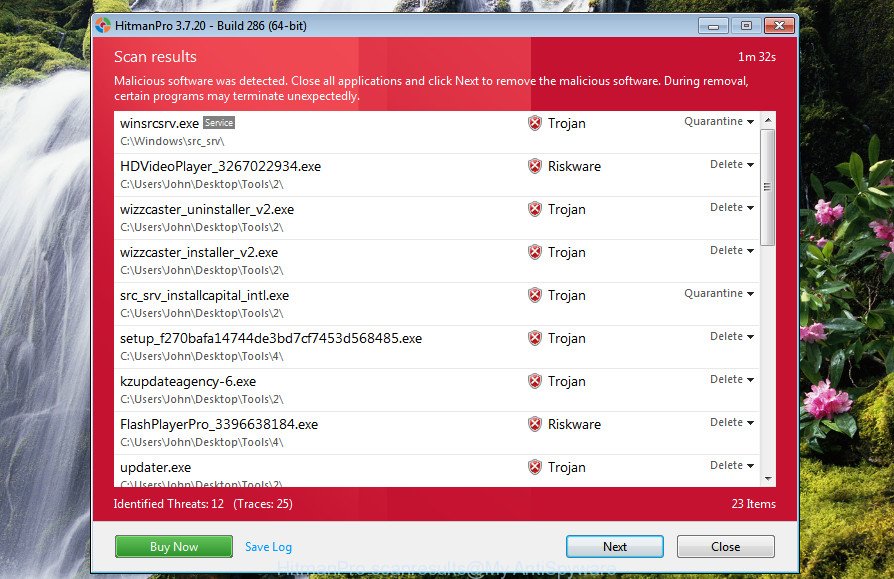
All detected items will be marked. You can remove them all by simply click “Next” button. It will display a dialog box, click the “Activate free license” button. The HitmanPro will get rid of adware that causes browsers to open misleading “Your computer was locked” pop-up warnings. After that process is finished, the utility may ask you to restart your personal computer.
Run MalwareBytes AntiMalware (MBAM) to get rid of “Your computer was locked” pop up scam
You can remove “Your computer was locked” popup automatically through the use of MalwareBytes Free. We advise this free malware removal utility because it may easily remove browser hijackers, ad-supported software, potentially unwanted software and toolbars with all their components such as files, folders and registry entries.
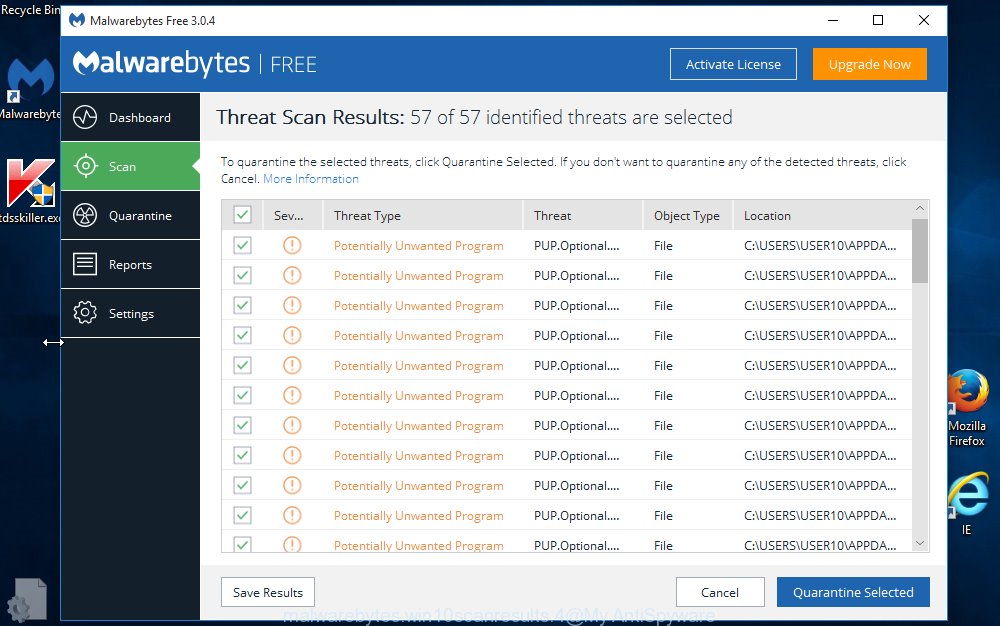
- Installing the MalwareBytes Anti Malware (MBAM) is simple. First you will need to download MalwareBytes AntiMalware (MBAM) on your MS Windows Desktop from the link below.
Malwarebytes Anti-malware
327070 downloads
Author: Malwarebytes
Category: Security tools
Update: April 15, 2020
- Once the downloading process is complete, close all applications and windows on your PC system. Open a folder in which you saved it. Double-click on the icon that’s named mb3-setup.
- Further, click Next button and follow the prompts.
- Once setup is done, click the “Scan Now” button to perform a system scan for the ad-supported software that causes multiple misleading “Your computer was locked” alerts and pop-ups. A scan can take anywhere from 10 to 30 minutes, depending on the count of files on your PC and the speed of your PC system. When a threat is found, the number of the security threats will change accordingly. Wait until the the checking is finished.
- After the scanning is finished, you can check all items detected on your computer. Review the report and then click “Quarantine Selected”. Once disinfection is finished, you may be prompted to reboot your computer.
The following video offers a guidance on how to remove hijackers, ad-supported software and other malicious software with MalwareBytes AntiMalware.
How to stop “Your computer was locked” popup scam
To put it simply, you need to use an ad blocker tool (AdGuard, for example). It will stop and protect you from all intrusive web-sites such as the “Your computer was locked” scam, unwanted ads and pop ups. To be able to do that, the ad-blocker program uses a list of filters. Each filter is a rule that describes a malicious site, an advertising content, a banner and others. The ad blocker application automatically uses these filters, depending on the web-pages you are visiting.
- Download AdGuard on your machine from the link below.
Adguard download
26842 downloads
Version: 6.4
Author: © Adguard
Category: Security tools
Update: November 15, 2018
- After downloading it, start the downloaded file. You will see the “Setup Wizard” program window. Follow the prompts.
- When the setup is finished, press “Skip” to close the setup program and use the default settings, or click “Get Started” to see an quick tutorial which will allow you get to know AdGuard better.
- In most cases, the default settings are enough and you don’t need to change anything. Each time, when you start your computer, AdGuard will launch automatically and stop unwanted pop up ads, “Your computer was locked” scam, as well as other malicious or misleading websites. For an overview of all the features of the program, or to change its settings you can simply double-click on the icon named AdGuard, that can be found on your desktop.
How did you get infected with “Your computer was locked” scam
The ad-supported software come bundled with some free programs. So always read carefully the setup screens, disclaimers, ‘Terms of Use’ and ‘Software license’ appearing during the install process. Additionally pay attention for bundled apps that are being installed along with the main application. Ensure that you unchecked all of them! Also, run an ad blocking program that will help to block malicious, misleading, illegitimate or untrustworthy websites.
To sum up
Now your PC system should be free of the adware which cause misleading “Your computer was locked” fake alerts to appear. We suggest that you keep Zemana (to periodically scan your computer for new ad-supported softwares and other malware) and AdGuard (to help you stop annoying pop-ups and harmful sites). Moreover, to prevent any adware, please stay clear of unknown and third party applications, make sure that your antivirus program, turn on the option to look for PUPs.
If you need more help with “Your computer was locked” pop-up warnings related issues, go to here.


















